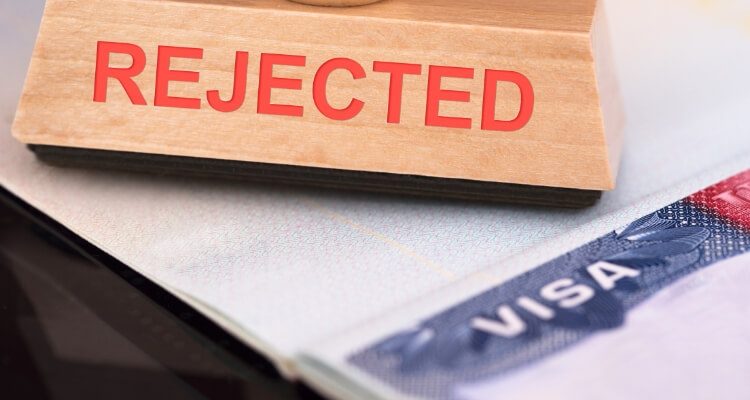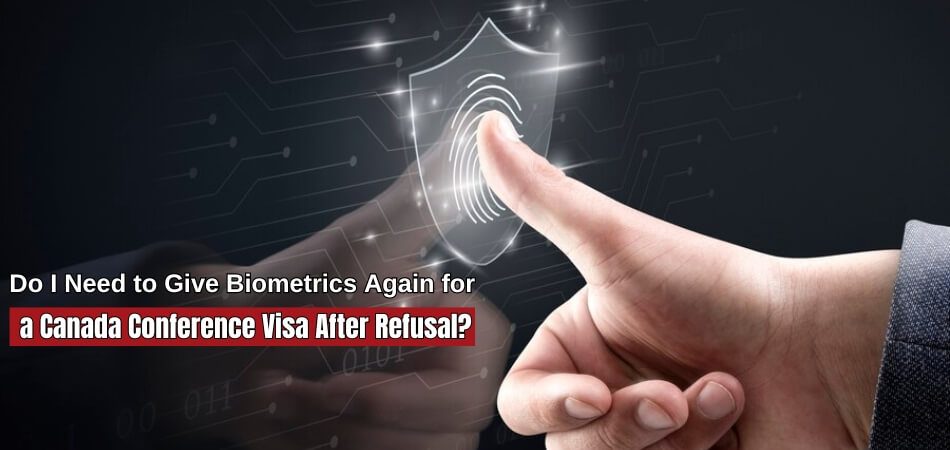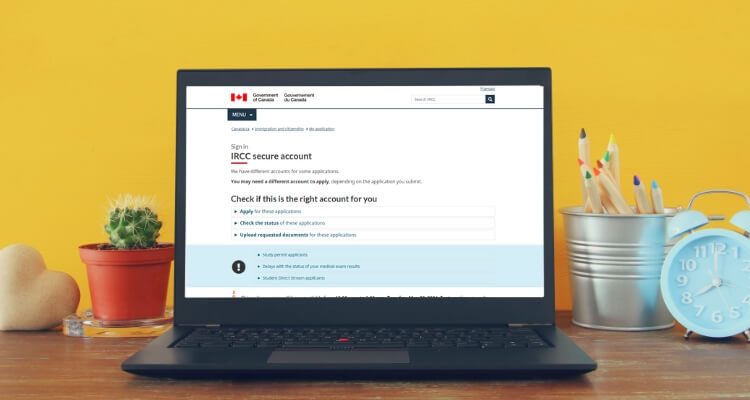Securing a Canada conference visa can feel like a milestone, especially for an important event. But if your application gets refused, it raises the question, do I need to give biometrics again for Canada conference visa after refusal? Biometrics play a critical role in Canadian visa processes, and understanding when you need to redo them can make a big difference.
If your biometrics are still valid—typically within a ten-year window—you may not need to submit them again. However, specific situations might require a fresh set, depending on updated requirements from IRCC.
Curious about when to reapply, the steps to follow, and practical tips for approval? Keep reading to explore everything you need for a successful reapplication process.
Why Do Visa Applications Sometimes Get Refused?
Visa refusals can be frustrating, especially when it’s for an important event. Recognizing the common reasons behind visa rejections can help applicants better prepare and avoid common pitfalls. Here are some key factors that might lead to a visa refusal:
Incomplete or Incorrect Documentation
When documents are missing or inaccurately filled out, it can lead to an immediate refusal. Immigration officials rely on accurate paperwork to verify eligibility and ensure compliance with visa requirements. Double-checking all documents before submission can save applicants time and avoid potential setbacks.
Insufficient Financial Proof
Demonstrating financial stability is essential to show that applicants can support themselves during their stay. Visa officers need to see enough financial proof, such as bank statements or sponsorship letters, to assess the applicant’s ability to cover travel and accommodation expenses. Insufficient financial details can raise concerns about the applicant’s intentions and lead to a rejection.
Unclear Purpose of Visit
Immigration officers need clear information about why an applicant is visiting, especially for conference visas. If the purpose of the trip seems vague or inconsistent, officers may question the legitimacy of the application, leading to potential visa rejection after biometrics submission. Providing detailed explanations of the conference and its relevance to your profession can help reduce doubts.
Past Immigration Violations
Previous visa refusals, overstays, or any legal issues related to travel can impact current applications. Visa authorities often check past travel records to assess trustworthiness. Being transparent about past issues and providing explanations if required can help mitigate this reason for refusal.
Failure to Meet Health or Security Standards
Some countries require applicants to meet specific health or security requirements. If an applicant fails to pass a health screening or security check, this could lead to a rejection. Meeting these standards is essential for entry approval in most visa processes.
By being aware of these common refusal reasons, applicants can better prepare and reduce the risk of setbacks, ensuring a smoother visa experience.
Do I Need to Give Biometrics Again for Canada Conference Visa After Refusal?
If your Canada conference visa was refused, you may not need to give biometrics again if they’re still valid, usually within a 10-year period. However, if IRCC requests a new submission due to updated information or policy changes, you’ll need to re-submit them accordingly.
Validity of Previous Biometrics
Typically, biometrics collected for Canadian visas are valid for ten years. This means if your biometrics were taken within that timeframe, there’s a good chance you won’t need to give them again, even if your visa was refused. However, you can check your IRCC account to confirm the validity period and ensure that your biometrics are still active.
Receiving a Biometrics Instruction Letter (BIL)
When reapplying, always check if you receive a new Biometrics Instruction Letter (BIL) from IRCC. A BIL informs you if fresh biometrics are required for your reapplication. If no new BIL is issued, it usually means your previous biometrics are still on file and do not need to be resubmitted. Staying alert to this letter helps avoid any unnecessary steps or fees.
Changes in Visa Requirements
Sometimes, visa category changes or specific IRCC updates might prompt a new biometrics submission. In most cases, if you are applying under a different visa category—such as attending a global conference in Canada or similar international events—IRCC may not request updated biometrics. The IRCC website can help clarify if any policy changes have been made.
Updates to Your Personal Information
Significant changes to personal information, like a name change or major updates to your passport, can also lead to IRCC requiring new biometrics.
This ensures that all biometric records match your current details, keeping your application secure and up to date.
Verifying your information before reapplying can help you anticipate whether a new submission will be necessary.
Payment of Biometrics Fee
When biometrics are required again, remember that the biometrics fee must be paid with your reapplication. This fee is separate from the general application fee and must be paid before the biometrics appointment is scheduled. Ensuring timely payment will keep the application process moving smoothly without delays.
Scheduling a New Biometrics Appointment
If a new biometrics submission is needed, book an appointment at the nearest Visa Application Center (VAC). During the appointment, you’ll provide updated fingerprints and a photo for verification purposes. Once completed, the VAC sends your biometrics to IRCC, linking them to your application for assessment.
In most cases, if your biometrics are still valid, resubmission is not required. However, following these guidelines and staying aware of IRCC notifications can help you handle your reapplication confidently. By ensuring all aspects of your application align with IRCC’s expectations, you increase your chances of a successful visa approval.
How to Reapply for a Canada Conference Visa After Refusal?
Reapplying for a Canada conference visa after a refusal may feel complicated, but learning the steps and addressing key areas can significantly improve your chances. Following these steps can make your reapplication stronger and more effective.
Analyze the Refusal Letter Carefully
Your refusal letter details why the visa was denied, providing a roadmap for improvement. By carefully reviewing these reasons, you can identify areas to strengthen in your reapplication. Addressing these specific concerns directly increases your chances of approval.
Ensure Complete and Accurate Documentation
Double-checking all required documents for accuracy and completeness is essential. Outdated or missing paperwork can lead to another refusal, so ensure each document is current and aligns with IRCC’s guidelines. Proper documentation presents a well-prepared application and builds confidence in your case.
Provide a Clear Purpose for Attending
Clearly explaining your conference attendance purpose can make a big difference. Emphasize the professional relevance and benefits of the event for your career. This clarity demonstrates commitment and strengthens your application by showcasing the event’s importance to your goals.
Establish Strong Ties to Your Home Country
Show that you intend to return to your home country by highlighting work, family, or personal obligations. Demonstrating strong ties reassures visa officers of your plans after the conference. Adding proof of these commitments reinforces the temporary nature of your trip.
Consider Seeking Professional Assistance
Immigration advisors can guide you through reapplying, helping to interpret refusal reasons and refine your application. Their expertise can clarify complex requirements, making your reapplication more compelling. A professional’s insight can boost your chances of a positive outcome.
By following these steps, you’ll approach your reapplication with more confidence. Addressing IRCC’s concerns and preparing thoroughly can lead to a more successful reapplication experience.
Tips to Ensure a Smooth Reapplication Process
The process of reapplying for a visa after a rejection can seem complicated, but there are a few steps you can take to make the process as simple as possible. Here are some practical tips to make your reapplication smoother and more successful.
- Review Refusal Reasons Thoroughly: Carefully analyze the refusal letter to understand where improvements are needed. Address each reason directly to strengthen your reapplication and avoid repeated mistakes.
- Double-Check Your Documents: Ensure all documents are up-to-date and complete. Missing or outdated paperwork often causes issues, so verify each item carefully before resubmitting.
- Emphasize Your Conference Purpose: Clearly outline how the conference aligns with your professional goals. This clarity helps immigration officers see the relevance of your visit to your career path.
- Show Strong Ties to Your Home Country: Provide proof of commitments, like work or family, to demonstrate your intent to return. Strong ties reassure officials about the temporary nature of your trip.
- Provide Additional Supporting Information: Including extra documentation, such as a letter from your employer, can add strength to your application. Additional proof supports your case and reinforces your reasons for attending the conference.
- Seek Professional Guidance if Needed: Consider consulting an immigration advisor for insights on refining your application. Their expertise can help clarify complex requirements and strengthen your case.
Reapplying with these tips in mind can significantly improve your chances of success. Addressing the concerns of immigration officials and presenting a thorough application sets you on the path to a smoother reapplication experience.
Steps to Make the Payment After Biometric Submission
Making the payment after submitting your biometrics is an essential part of the visa application process. Ensuring that the payment is made correctly and on time helps keep your application on track. Here are the steps to follow for a smooth payment experience:
Access the Official IRCC Payment Portal
Visit the official Immigration, Refugees and Citizenship Canada (IRCC) website to access the payment portal. The site provides secure and easy-to-follow instructions for paying online. Confirm that you’re on the official IRCC portal to avoid any security risks.
Select the Payment Category
Choose the appropriate category for your payment, such as the visa application fee, biometrics fee, or other required charges. Each fee category is clearly labeled to help you select the right option, especially when making your biometrics payment after submitting application details. Selecting correctly avoids delays in the processing of your application.
Choose Your Payment Method
IRCC’s payment portal accepts various methods, including credit cards and certain debit cards. Make sure your payment card is authorized for international transactions to avoid payment issues. Confirming your method beforehand ensures a hassle-free transaction.
Complete the Payment and Print the Receipt
Once the payment is processed, save a digital copy and print the receipt as proof of payment. The receipt is essential for tracking your payment status with IRCC. This proof also serves as documentation if any payment-related issues arise.
Attach the Payment Receipt to Your Application
Place the payment receipt with your other visa documents to keep everything organized. This step shows that all required fees have been paid, helping the application process move forward without unnecessary delays.
Following these steps carefully can ensure that your payment process goes smoothly. With attention to each detail, you can complete this step and advance confidently in your visa application.
How to Check the Validity of Your Biometrics?
Checking the validity of your biometrics is essential for ensuring a smooth visa application process. Knowing if your biometrics are still valid can save you from unnecessary re-submissions and potential delays. Here’s how you can confirm your biometrics status effectively:
Log into Your IRCC Account
Access your IRCC (Immigration, Refugees, and Citizenship Canada) account to review your biometrics status. Within your account, you’ll find details on your last biometrics submission, including its validity period. This online check provides a quick way to confirm if your biometrics are still active.
Check Your Biometrics Confirmation Letter
After submitting biometrics, IRCC issues a Biometrics Confirmation Letter that includes the submission date and validity duration. This letter is a helpful reference for tracking the timeline of your biometrics without needing an online account. Keep this letter in a safe place as it may be necessary for future applications.
Contact IRCC if Needed
If you’re unsure about your biometrics validity or face any issues accessing your account, contacting IRCC directly can provide clarification. Their customer service team can confirm your biometrics status and offer guidance if a new submission is required. Reaching out ensures you have accurate, up-to-date information.
Checking your biometrics validity keeps your application process on track and helps avoid unexpected issues. By taking these steps, you’ll be prepared and ready for the next phase of your visa process.
Frequently Asked Questions (FAQs)
If you’re reapplying for a Canada conference visa after a refusal, you might have a few additional questions in mind. Here are some common concerns travelers often have when dealing with biometrics and reapplication processes.
Do I Need To Pay The Biometrics Fee Again If My Visa Was Refused?
Yes, in most cases, you’ll need to pay the biometrics fee if you’re asked to submit them again. However, if your previous biometrics are still valid, the IRCC won’t require a new fee, saving you the extra expense.
Can I Reuse My Biometrics If I Apply For A Different Type Of Canada Visa?
Typically, yes. As long as your biometrics are still valid, you can reuse them for other types of Canadian visas, such as study or work visas. This rule makes it convenient when switching between visa types within the ten-year validity period.
What Happens If I Can’t Provide Biometrics Due To A Medical Condition?
In cases where a medical condition prevents you from providing biometrics, IRCC may offer accommodations. Reach out to IRCC with proper documentation about your condition, as they may guide you on alternative procedures for your visa application.
How Long Does It Take For Biometrics To Be Updated In My Application Status?
Once you’ve submitted your biometrics, it usually takes a few days for IRCC to update your application status. However, processing times can vary, so it’s best to check your IRCC account regularly for the most current updates.
Can I Request An Extension If I’m Unable To Submit Biometrics On Time?
Yes, if you face unexpected delays, you may request an extension from IRCC. It’s crucial to contact them as early as possible, explaining the reasons for your delay, as they may allow extra time to submit biometrics under certain circumstances.
Conclusion
Reapplying for a Canada conference visa can feel like a maze of requirements, especially if you’re unsure about “Do I need to give biometrics again for Canada conference visa after refusal?” Checking the validity of your biometrics is the first step, as they are typically valid for ten years.
If your biometrics remain valid, you can likely skip re-submission, streamlining your reapplication process. However, IRCC guidelines or specific changes in your application could still require new biometrics. Staying informed and following IRCC instructions closely is essential.
With a solid knowledge of these steps, you’re better prepared for a successful reapplication. Ensuring your biometrics and other documents meet requirements can help you avoid delays and keep your progress toward your Canada conference on track.








